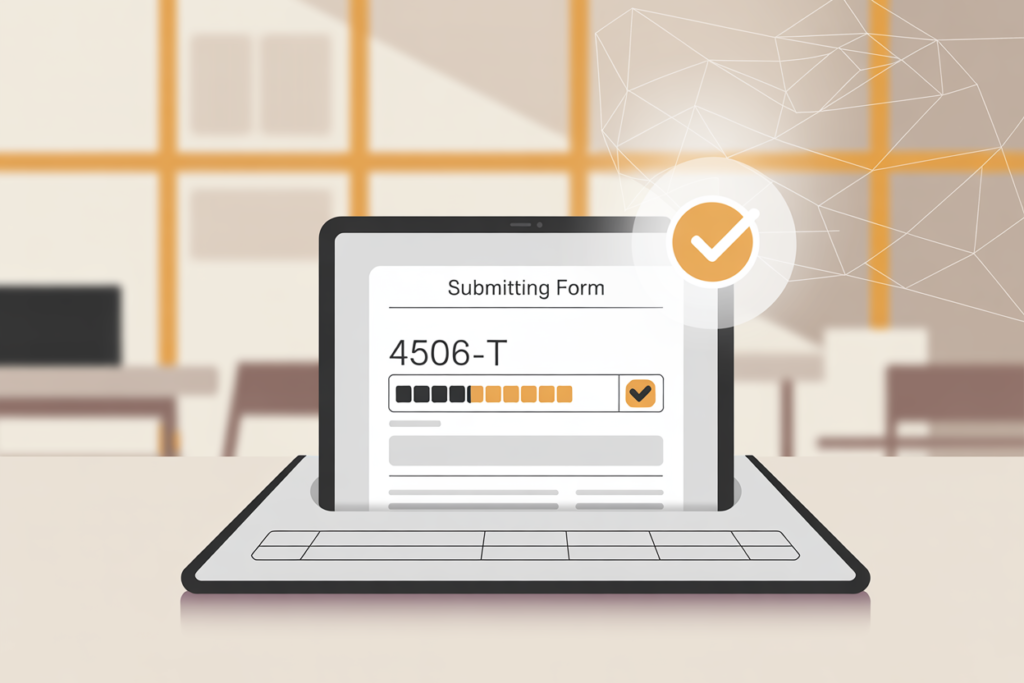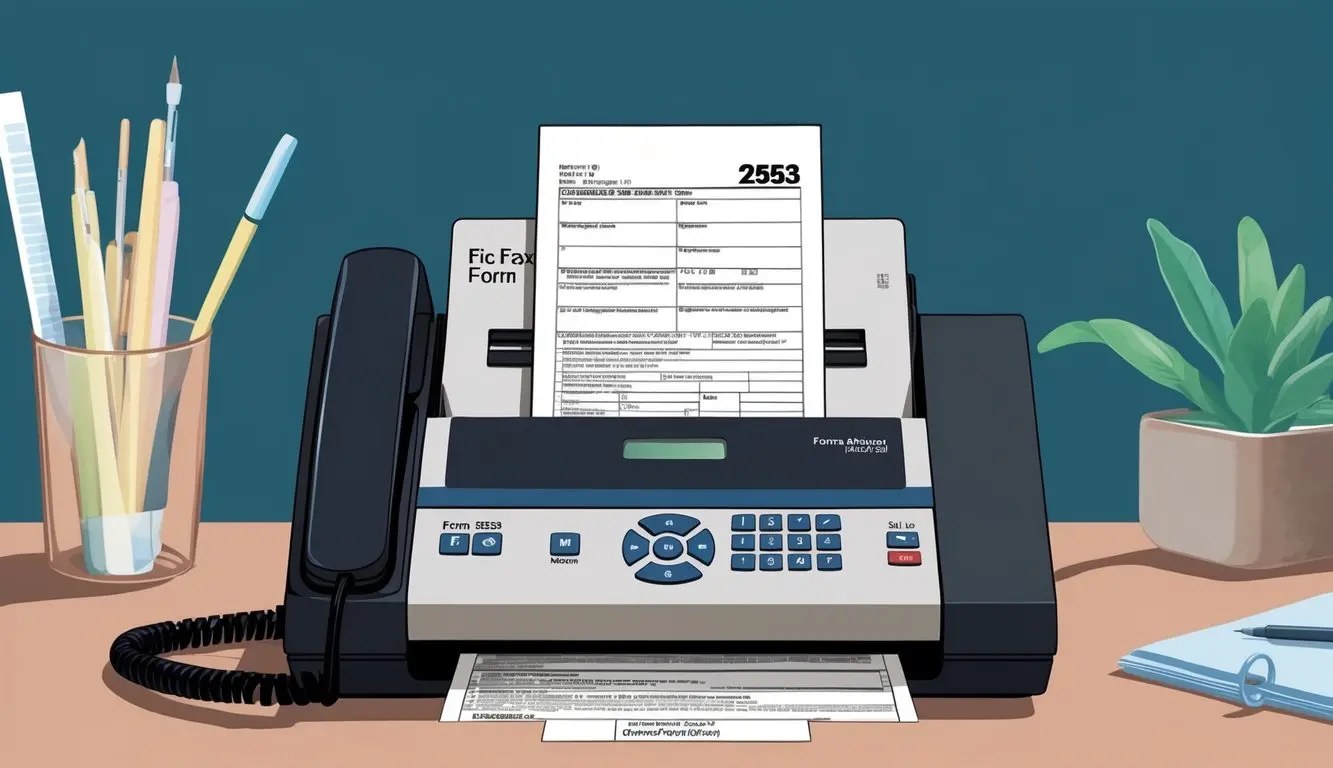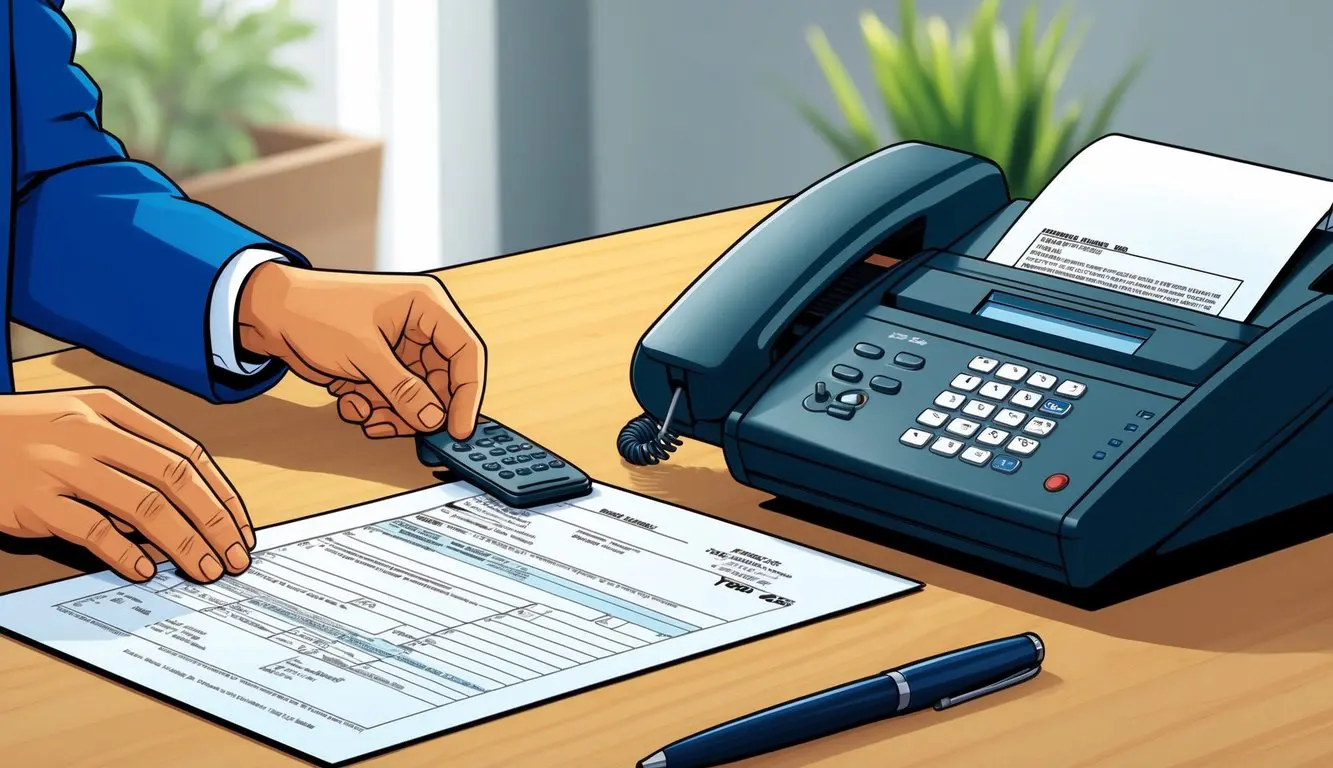Faxing Form 4506-T—a simple tax transcript request that can feel oddly intimidating. People ask if it’s truly necessary to fax IRS Form 4506-T rather than just emailing or mailing it; the IRS says yes, faxing is allowed, but only to the numbers listed for your state. If you need your tax transcript fast for a mortgage, financial aid, or other documentation, faxing Form 4506-T is often the quickest way to get results (see the official IRS filing guide for Form 4506-T).
You can already see why using a fast and reliable platform matters. People scramble for the right fax number, worry if they filled the form correctly, and race against paperwork deadlines. It’s not glamorous, but the relief when the IRS transcript lands in your inbox right when you need it? That’s real peace of mind. Services like Municorn Fax help skip the hassle—ditch the old fax machine, upload your document online, and securely send your IRS Form 4506-T in minutes, whether you’re at home or sitting in the coffee shop.
And honestly, who wants to wait weeks for the mail or cross their fingers with email? Getting those transcripts can open doors to loans, college, or just clarity about your taxes. Faxing remains the trusted, preferred option for many, and these days, you don’t need bulky machines or office drama to make it easy.
What Is Form 4506-T and Why Fax It?
Form 4506-T makes life a little less complicated for anyone who needs to get a tax return transcript from the IRS without scrambling for old paperwork. Taxpayers, loan officers, and even businesses pick it for fast retrieval, especially when timelines are tight or paperwork gets lost in the shuffle.
Purpose of Form 4506-T
Form 4506-T is the official “Request for Transcript of Tax Return.” It’s not just any form—it’s a gateway for those looking to view or send their past tax return information without requesting a full copy of their entire return, which would require using Form 4506 instead. Why does that matter? Sending a transcript instead of the full return is faster, cheaper, and generally all that lenders or schools need when checking your financial records.
This form asks for your name, taxpayer identification number (which could be your Social Security number or your Individual Taxpayer Identification Number), current address, and the address on your last file. The form can also request specific types of transcripts, like those for W-2s or 1099s, letting you tailor the IRS response. It’s a focused approach that skips the fluff and goes straight to what you need.
A lot of people—homebuyers, students applying for aid, or even folks just straightening out their records—find this form essential. The IRS uses it to protect taxpayer data, making sure only approved parties get transcripts. Precision matters; a typo can send your request into oblivion, and you’ve got to sign as your name appeared on the original return—no shortcuts here.
Faxing vs. Other Submission Methods

Here’s the thing: there are a couple of ways to send Form 4506-T, but faxing has some immediate perks that stand out. Mailing is slow—potentially weeks for a response if you’re unlucky. Online submission is possible, but not all transcript types or situations allow for it. When time is tight, fax speeds things up.
Today’s online fax platforms (think Municorn Fax and others) make sending IRS forms from anywhere almost too easy. You get that digital convenience and a delivery confirmation for your peace of mind. The IRS actually posts designated fax numbers by state or return type, so you don’t have to guess if your document went to the right place. That’s not only fast, but safer than handling paper.
But let’s not sugarcoat it—sometimes a faxed copy blurs or jams, but online services curb a lot of these issues by letting you attach PDFs from a phone or PC. Digital timestamping adds an extra layer of security—no lost case numbers, no wondering if the post office ate your form. Speed, tracking, and broad access make faxing a favorite when working with deadlines.
When to Use a Faxed 4506-T
A faxed Form 4506-T is a lifesaver when deadlines loom or paperwork needs a turbo boost. Mortgage applications? Lenders will often ask for a tax return transcript sent right from the IRS. Financial aid offices and loan servicers also lean on transcripts, not full tax returns, for their decisions.
If a taxpayer needs a transcript for official use—say, for disputes, visa applications, or to untangle a tax account—faxing Form 4506-T knocks down the waiting time. This route is especially valuable when needing a specific tax year’s info, like W-2 or 1099 details, for proof of income.
For anyone with a changed address, legal name, or using an Individual Taxpayer Identification Number instead of a Social Security number, double-checking the form before faxing is key. The IRS doesn’t want mistakes slowing down their process either. Schools, accountants, and business partners rely on this simple tool, especially when time and accuracy carry real weight.
Plus, being able to fax right from a phone or a secure web portal? Game changer—especially for those who need to keep moving without getting bogged down in paper trails.
Key Components of Form 4506-T

Form 4506-T is all about getting tax return transcripts fast and securely, especially when banks or agencies ask for proof. Each section of the form carries special importance, from filling in personal details to making sure the right boxes are checked for the correct year and transcript type.
Required Personal Information
The top of Form 4506-T asks for details that confirm who’s requesting information and links the request back to IRS records. There’s no room for error—this part sets the tone for everything else on the page.
People should enter their full legal name as it appears on their tax return. They’ll need to put their Social Security Number (SSN) or, for businesses, the Employer Identification Number (EIN). Addresses matter—if someone moved since filing their last return, they’ll have to provide both their old and current addresses to make sure the right records are found.
It’s important to double-check every line. Just a single misplaced letter or number can lead to frustrating IRS processing delays. Joint filers should include both names and SSNs for accuracy, while businesses must enter the company name and EIN clearly. If legal names have changed—say, after a marriage or divorce—the current and prior names must both be shown on the form. It’s all about making sure nothing slips past the reviewer’s eye.
Line-by-Line Breakdown
Each part of Form 4506-T, from line 1a through line 6, asks for a specific piece of information. Line 1a and 1b capture the filer’s name and tax identification info—pretty standard, but absolutely vital. Line 2a and 2b, if applicable, collect spouse or business partner details. Line 3 wants the address where the last return was filed. It sounds obvious, but a wrong street number or zip code derails things quickly.
There’s a table in the middle that specifies what year or period is being requested—usually listed as “year or period requested.” It’s as literal as it gets. People must fill this in clearly, or the IRS just can’t process the request. Further down, the tax form number asked for (like Form 1040, Form W-2, or others) tells the IRS exactly which document transcript is needed. Line 6 lets users pick which transcript type they want.
It ends with the signature area—never optional. The IRS won’t send anything without a real signature. Corporations require an officer who can legally represent the company, so it’s not always just any employee. For further details on specific line requirements straight from the government, check the 4506-T IRS form PDF.
Types of Transcripts Requested
Form 4506-T isn’t just for one type of tax document. It allows people to request different transcripts based on specific needs. Here’s where it matters: banks, schools, or even other government agencies may each ask for different forms.
Users can select a Return Transcript, which covers the bulk of filed Form 1040 returns. Others may need a Tax Account Transcript—this one summarizes basic data, like payments and account changes, but doesn’t show actual lines from the return. There’s also a Wage and Income Transcript; this pulls information directly from Forms W-2, 1099, 1098, and 5498—so it’s a must for people piecing together income history.
Another option is the Verification of Non-filing Letter—it simply states that the IRS has no record of a filed return for a given year. It might seem odd until a financial aid office asks for proof someone didn’t have to file. Choosing the correct transcript matters a lot; otherwise, someone could end up with useless paperwork. And if anyone’s wondering, requesting multiple transcript types doesn’t slow things down, as long as all relevant lines are filled out accurately.
Here’s a quick look:
- Return Transcript: Info from Form 1040
- Account Transcript: Basic IRS data
- Wage and Income Transcript: Shows data from W-2, 1099, and more
- Verification of Non-filing: Proves no return was filed
Common Mistakes to Avoid
Even the most detail-oriented people can make slip-ups on Form 4506-T. Sometimes it’s a tiny typo; sometimes, it’s forgetting to sign at the bottom. Both can send the request straight back—wasting days (or weeks) of time. Double-checking personal information—SSN, EIN, addresses—reduces mix-ups.
Writing “see attached” instead of filling out each line is risky. The IRS loves its boxes carefully filled—no side notes allowed. Skipping the tax year or period requested is another pitfall; anyone who leaves this blank will not get the paperwork they want.
Another trouble spot: picking the wrong tax form number or transcript type. If the request is for a mortgage and someone chooses the wrong box, they may have to redo everything. Using outdated forms or unsigned forms also causes rejections—always make sure to grab the latest version.
A helpful tip: review the latest instructions, like those found at Tax Sights, and keep a checklist handy. And, if ever faxing, use a reliable tool like Municorn Fax so documents arrive crisp and intact. It’s easy to overlook, but a good digital fax service helps ensure all that effort filling out Form 4506-T isn’t wasted.
How to Fax Form 4506-T to the IRS

Faxing Form 4506-T is a quick way to request tax transcripts from the IRS. Getting the right IRS fax number, preparing the form, and timing the submission makes a difference for getting those records fast.
Finding the Correct IRS Fax Number
It’s easy to get tripped up by all the different IRS addresses and fax numbers floating out there. The IRS uses separate fax numbers based on where the taxpayer lived when the original return was filed. Double-checking this detail is crucial, especially if there’s been a change of address since filing or the request involves different years.
The IRS publishes an address chart online that lists each address and fax number for Form 4506-T submissions. Some locations require faxing to a P.O. box team or specific RAIVS team based on region. If the return covers the current year or prior years, use the state from the original filing as your guide.
Online fax guides, like those explaining fax numbers for the IRS, can make this whole process even less confusing. Honestly, nothing is worse than sending your form off to limbo just because of a digit mix-up.
Preparing the Form for Faxing
Accuracy matters. IRS agents look for legible, signed forms. Grab the official Form 4506-T PDF from IRS.gov and fill it out following all the prompts. Don’t forget the taxpayer signature—it needs to be wet ink if possible. Typing a signature or leaving it out gets forms rejected all the time.
Always use dark ink, scan at high resolution, and keep all information well within the form’s borders. If you’re requesting transcripts for multiple years, check all boxes accurately and make sure “current year requests” and “prior year requests” line up with IRS instructions. Include your contact information, including any recent change of address, to speed up the process.
Consider secure options for faxing—using a reliable online fax service helps ensure proper delivery, keeps sensitive details safer, and often provides confirmation when your document lands.
Timing for Submission and Processing
Timing can feel like a guessing game, but there’s some sense to it. IRS processing for faxed 4506-T forms typically takes about 10 business days, though it can move faster in slower seasons or for single-year requests. You know what? Submitting mid-week, before holidays, generally avoids the worst of the IRS’s backlog.
If you’re on a deadline, build in a buffer for possible rejections (especially if the IRS requests a corrected version). Always save the confirmation page from your fax—this can be a lifesaver with the IRS if records go missing or “get delayed,” as happens from time to time.
Some folks fax forms early in the morning for a quicker timestamp; others prefer late afternoon hoping it’ll hit the next day’s stack. The real trick is to follow up if you haven’t heard back after two weeks. Call the IRS or use their transcript status tool online so you’re not left waiting in the dark. Remember, each tax year or request might need its own submission, especially if you’re making requests for different financial institutions.
Use Cases for Form 4506-T Fax Requests
Faxing Form 4506-T can save valuable time when proof of income or official tax transcripts are needed quickly. It’s a reliable way for people to handle paperwork required by banks, schools, and other agencies—and sometimes, speed makes all the difference.
Income Verification for Loans
Banks and mortgage companies don’t mess around with income checks. If someone wants a car loan, mortgage, or even just a small business line of credit, proof of income is a non-negotiable. That’s where Form 4506-T steps in.
A faxed request can get the transcript to the lender much faster than regular mail, which often helps keep the loan application moving along. Lenders use transcripts pulled directly from the IRS to double-check reported earnings—ensuring borrowers aren’t stretching the truth on their paperwork. It’s a key part of making sure no one gets in over their head with a loan.
Here’s the thing: sometimes, life happens and important documents go missing. Faxing Form 4506-T can be a real lifesaver when digital access isn’t cutting it or isn’t an option. Plus, using an online service means you won’t be left hunting for a working fax machine late at night.
Obtaining Tax Transcripts for Financial Aid
When applying for financial aid, especially through programs like FAFSA, schools and government agencies want to verify how much money was made last year. They don’t just take someone’s word for it—they want official tax transcripts.
A Form 4506-T, faxed directly to the IRS, helps students or parents get these transcripts faster. For tight college deadlines, waiting for mail delivery can feel like an eternity. But fax? That’s much quicker. The transcripts are then sent straight from the IRS, adding trust to the process.
Here’s another point: colleges can request the IRS send the transcript straight to them, cutting out extra steps and making things simpler for students. Sometimes, families file joint returns or move addresses, and this form smooths the bumps by confirming details—meaning fewer administrative headaches.
Verification of Non-Filing
Not everyone files a return every year. Sometimes, it’s just not required by law. But when someone needs to prove they didn’t file—say, for government benefits or special student aid programs—the IRS issues something called a verification of non-filing letter.
Form 4506-T is the tool for the job. Faxed requests for this verification can help meet strict program requirements on short notice. These letters are often needed for aid applications, grants, or even when a person applies for certain public benefits.
Occasionally, a school or agency will ask for this letter to confirm the applicant isn’t hiding missing income. It adds a layer of transparency and puts everyone on the same page—no surprises, just the facts. For more on these scenarios, the IRS shares further guidance on verification of non-filing requests.
Special Considerations for Different Taxpayers
Specific forms and requirements around faxing Form 4506-T can catch taxpayers off guard—especially when requests aren’t so simple. The process can feel like jumping through hoops, but understanding the details can prevent frustrating delays.
Third-Party and Tax Professional Requests
When tax professionals, lenders, or someone acting on someone else’s behalf needs to request a tax transcript, it’s not just about filling out Form 4506-T and faxing it off. They’ll usually need proof they’re allowed to do this. This often means sending a signed Power of Attorney, usually Form 2848, along with the fax.
Here’s the thing: The IRS looks for specific signatures and matching information on both forms. If any names or Social Security Numbers don’t match, that transcript request might get held up or bounced right back. There’s no shortcut—authorization must be crystal clear and match the IRS’s records.
For those handling requests for clients or family members, it helps to double-check details before faxing anything. The IRS also recommends including a unique customer file number on the form—a handy way for tax professionals to track the transcript once it’s processed. It’s a bit like writing your initials on your lunch so nobody else grabs it.
Requests for Multiple Tax Years
Requesting transcripts for several tax years? There’s a trick to it—Form 4506-T lets taxpayers ask for up to four years or periods per form. That sounds simple, but if someone needs even more years, they’ll need to prepare extra forms. It’s a bit repetitive, but that’s the rulebook.
If requesting transcripts for the 1040, W-2, or even an amended return, they’ll want to list the exact years in the order requested. Mixing up the years or leaving lines blank can slow everything down. For those using fax, placing each Form 4506-T in a clear order stacks the deck toward faster processing.
Some individuals are surprised that short form requests for individual tax return transcripts—like those needed for student loans or mortgage applications—are among the most common, especially when institutions only want the basics. It’s best to clarify which transcript type is required, as the wrong choice will leave everyone back at square one.
Requests Outside the 50 States and for U.S. Territories
Living outside the traditional 50 states, or calling a U.S. territory like Puerto Rico or Guam home? The process for faxing Form 4506-T changes a bit. The IRS assigns different fax numbers and addresses for these locations, which affects where you send the form. It’s not just bureaucracy—using the wrong address can mean your form vanishes into a black hole.
Here’s a quick table to clear things up:
| Location | Where to Fax/Mail |
|---|---|
| Foreign country | Special IRS addresses and fax numbers |
| American Samoa, Puerto Rico, Guam | Use IRS central locations for these territories |
| Northern Mariana Islands, U.S. Virgin Islands | Follow specific instructions for island residents |
Those living abroad must be extra careful to use the right contact details as found on the IRS official address chart. Faxing to a U.S. mainland location from a foreign country? Double-check your transmission went through—and maybe stash that confirmation page just in case. These little steps keep everything moving and save time when you just want your transcript without the extra chase.









